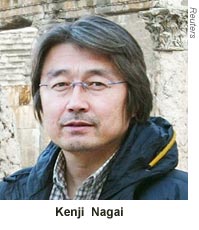New York, September 28, 2007 — The Committee to Protect Journalists is outraged by the apparently deliberate fatal shooting of Japanese cameraman Kenji Nagai by a Burmese soldier on Thursday. Video footage shown on Japan’s Fuji News Network reveals that Nagai, who was filming near a group of demonstrators in Yangon, was pushed to the ground and shot at near point-blank range.
The Japanese embassy in Burma said the bullet entered Nagai’s body from the lower right side of his chest, pierced his heart, and exited from his back. Their statement contradicts Burmese authorities’ claims that Nagai was killed by a stray bullet. Nagai, dressed in shorts and sandals, was clearly a foreigner and a journalist, who was carrying a video camera at the time he was shot.
“The government’s use of violence to suppress political dissent has now taken the life of a journalist,” said Joel Simon CPJ’s executive director. “The apparently cold-blooded killing of Kenji Nagai by Burmese government troops cannot go unaddressed. We call on the government to ensure the safety of all journalists covering this unrest.”
Nagai, 50, who was working for APF News, a video and photo agency based in Tokyo, was one of at least nine people killed by government troops during anti-government demonstrations yesterday, according to official state-run television. Another 11 demonstrators and 31 security force members were injured, the broadcast said.
Even before the video surfaced, the Japanese government lodged a formal protest with the Burmese government and sent a senior diplomat to the capital to seek clarification of Nagai’s death. And as the anti-government demonstrations continue, a special United Nations envoy, Ibrahim Gambari, will go to Burma to try to convince the military government to end the violence and negotiate with pro-democracy leaders.
As the violence and confrontations continue, the government has increasingly clamped down on Internet communications inside and out of the country. On Friday, all Internet connections were severed, according to Burmese exiles. With Burma largely closed to international journalists and the Burmese media heavily controlled by the government, much of the coverage of the past weeks’ demonstrations had been reported by bloggers and Web sites run by exiles.
